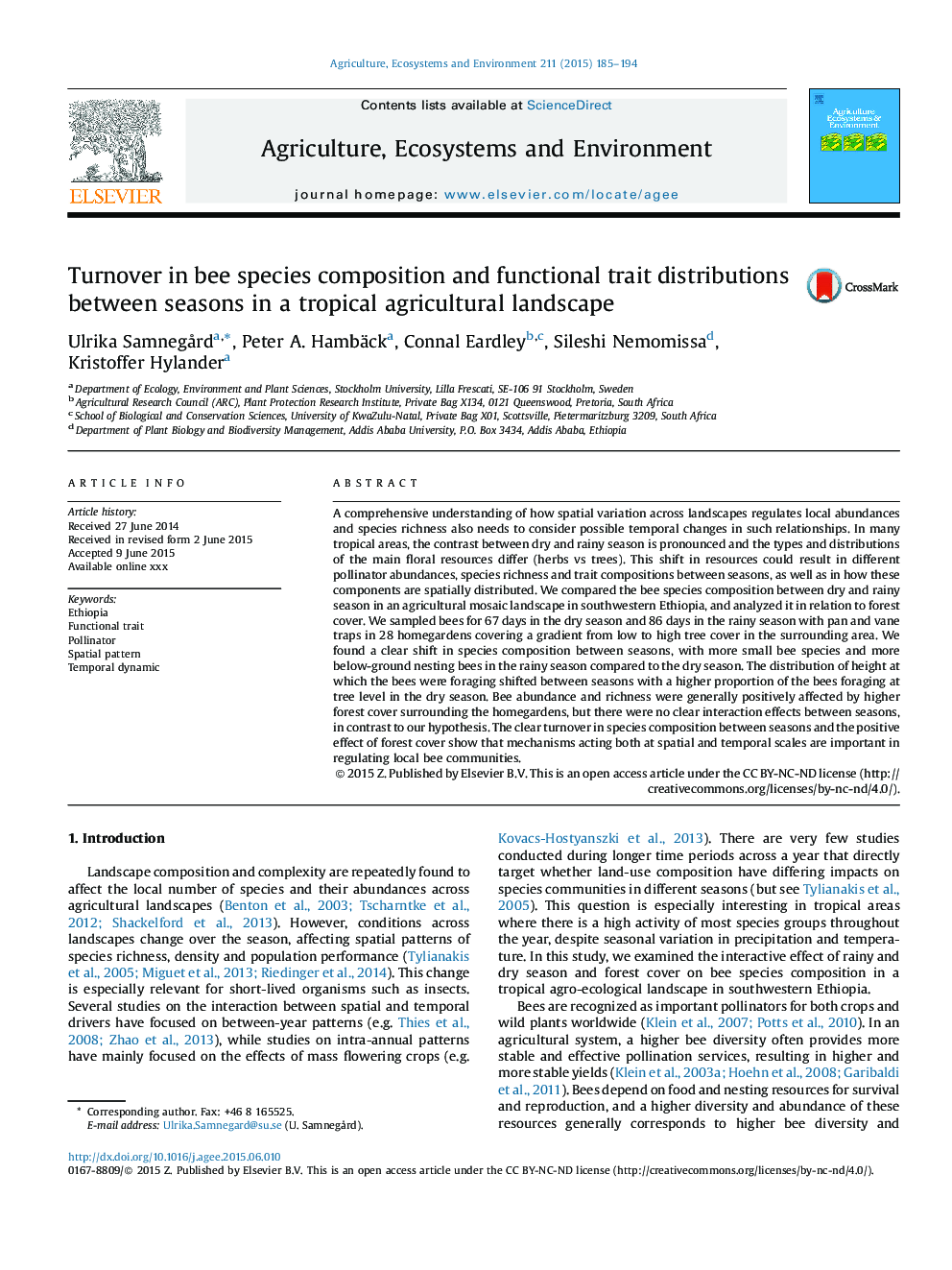| کد مقاله | کد نشریه | سال انتشار | مقاله انگلیسی | نسخه تمام متن |
|---|---|---|---|---|
| 8487675 | 1552041 | 2015 | 10 صفحه PDF | دانلود رایگان |
عنوان انگلیسی مقاله ISI
Turnover in bee species composition and functional trait distributions between seasons in a tropical agricultural landscape
ترجمه فارسی عنوان
گردش در ترکیب گونه های زنبور عسل و توزیع صفات عملکردی بین فصول در یک منظره کشاورزی گرمسیری
دانلود مقاله + سفارش ترجمه
دانلود مقاله ISI انگلیسی
رایگان برای ایرانیان
کلمات کلیدی
اتیوپی، صفات کاربردی، گرده افشانی، الگوی فضایی، پویای زمانبندی
ترجمه چکیده
درک جامع از اینکه چگونه تنوع فضایی بین منظره ها، فراوانی های محلی و غنای گونه را تنظیم می کند، همچنین باید تغییرات زمانی در چنین روابطی را مد نظر قرار دهد. در بسیاری از مناطق گرمسیری، کنتراست بین فصل خشک و بارانی بیان شده و انواع و توزیع منابع اصلی گل متفاوت است (گیاهان در مقابل درختان). این تغییر در منابع می تواند منجر به فراوانی گرده افشان های مختلف، غنای گونه و ترکیب صفت بین فصل ها و همچنین نحوه توزیع فضایی این اجزاء شود. ما ترکیب گونه های زنبور عسل را در فصل خشک و بارانی در منظر کشاورزی موزاییک جنوب غربی اتیوپی مقایسه کردیم و آن را در ارتباط با پوشش جنگل مقایسه کردیم. ما زنبورها را برای 67 روز در فصل خشک و 86 روز در فصل بارانی با تله های تابه و تپه در 28 خانه گاردن که نمونه ای از پوشش کم ارتفاع به درخت در اطراف آن را پوشش می دادند، جمع آوری کردیم. ما تغییر شگفت انگیزی در ترکیب گونه ها بین فصول، با گونه های کوچکتر زنبور عسل و بیشتر زنبورها را در فصل بارانی در مقایسه با فصل خشک مشاهده کردیم. توزیع ارتفاعی که زنبورها در طی فصل با تغذیه علوفه در سطح درختان در فصل خشک، نسبتا زیادی را نسبت به فصلهای مختلف تغییر دادند. فراوانی و غنای زنبورها عموما تحت تأثیر پوشش جنگلی بالایی قرار گرفته در اطراف خانه های باغبانی بود، اما در مقایسه با فرضیه ما، اثرات متقابل بین فصل ها وجود نداشت. گردش روشن در ترکیب گونه بین فصل ها و اثر مثبت پوشش جنگل نشان می دهد که مکانیسم های عمل در هر دو مقیاس فضایی و زمانی در تنظیم جوامع زنبور عسل بسیار مهم هستند.
موضوعات مرتبط
علوم زیستی و بیوفناوری
علوم کشاورزی و بیولوژیک
علوم زراعت و اصلاح نباتات
چکیده انگلیسی
A comprehensive understanding of how spatial variation across landscapes regulates local abundances and species richness also needs to consider possible temporal changes in such relationships. In many tropical areas, the contrast between dry and rainy season is pronounced and the types and distributions of the main floral resources differ (herbs vs trees). This shift in resources could result in different pollinator abundances, species richness and trait compositions between seasons, as well as in how these components are spatially distributed. We compared the bee species composition between dry and rainy season in an agricultural mosaic landscape in southwestern Ethiopia, and analyzed it in relation to forest cover. We sampled bees for 67 days in the dry season and 86 days in the rainy season with pan and vane traps in 28 homegardens covering a gradient from low to high tree cover in the surrounding area. We found a clear shift in species composition between seasons, with more small bee species and more below-ground nesting bees in the rainy season compared to the dry season. The distribution of height at which the bees were foraging shifted between seasons with a higher proportion of the bees foraging at tree level in the dry season. Bee abundance and richness were generally positively affected by higher forest cover surrounding the homegardens, but there were no clear interaction effects between seasons, in contrast to our hypothesis. The clear turnover in species composition between seasons and the positive effect of forest cover show that mechanisms acting both at spatial and temporal scales are important in regulating local bee communities.
ناشر
Database: Elsevier - ScienceDirect (ساینس دایرکت)
Journal: Agriculture, Ecosystems & Environment - Volume 211, 15 December 2015, Pages 185-194
Journal: Agriculture, Ecosystems & Environment - Volume 211, 15 December 2015, Pages 185-194
نویسندگان
Ulrika SamnegÃ¥rd, Peter A. Hambäck, Connal Eardley, Sileshi Nemomissa, Kristoffer Hylander,
